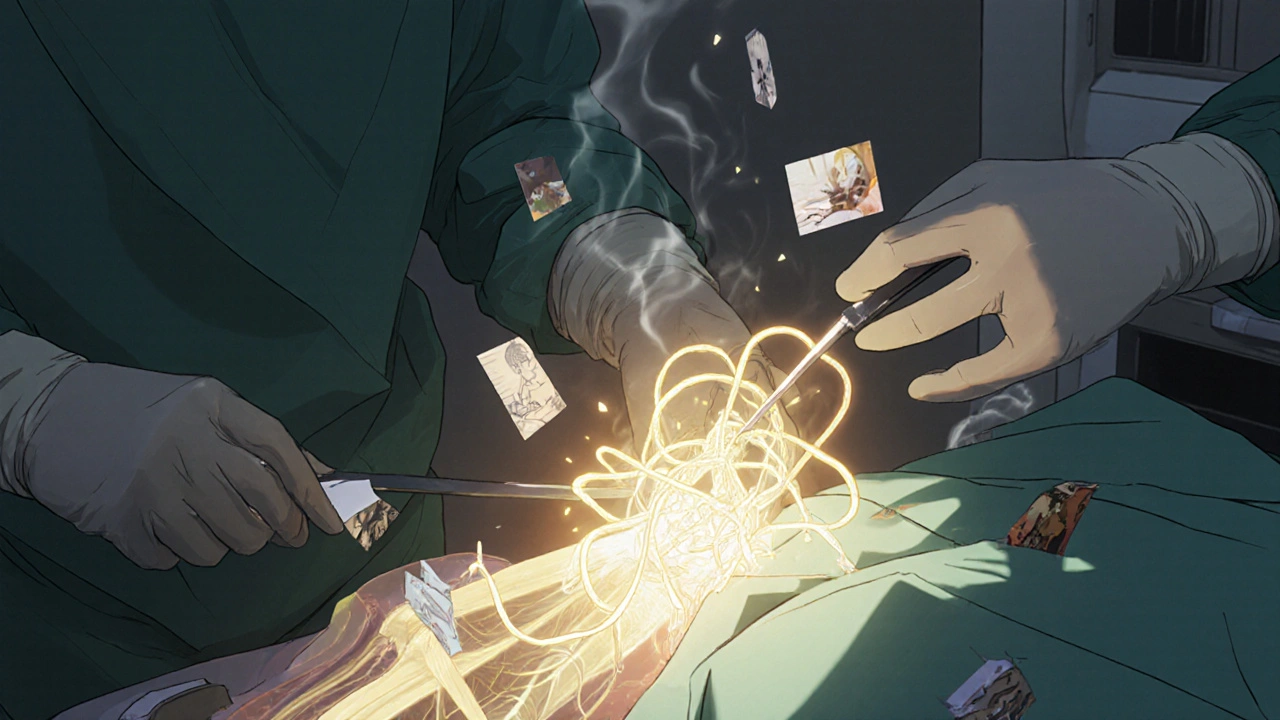Wrist pain that keeps you up at night? Tingling in your thumb, index, and middle finger? If you’ve been shaking your hand out like you’re trying to dry it after washing, you’re not alone. Carpal tunnel syndrome is one of the most common nerve problems in adults, affecting 3 to 6% of the population. It’s not just from typing too much - though that’s a myth many still believe. The real issue is pressure on the median nerve as it squeezes through a tight tunnel in your wrist. Left untreated, it can lead to permanent weakness, muscle loss, and lasting numbness.
What Exactly Is Carpal Tunnel Syndrome?
Your wrist isn’t just bone and skin. Inside it lies a narrow passageway called the carpal tunnel, made up of wrist bones on the bottom and a tough ligament on top. Through this tunnel run nine tendons that bend your fingers and, critically, the median nerve. This nerve controls sensation in your thumb, index, middle, and half of your ring finger. When the tunnel gets too tight - from swelling, inflammation, or repetitive motion - the nerve gets squished. That’s carpal tunnel syndrome. Normal pressure inside the tunnel is just 2 to 10 mmHg. When it climbs above 30 mmHg, the nerve’s blood supply starts to fail. That’s when symptoms begin. You might feel pins and needles, burning, or numbness - especially at night. Studies show 89% of people with CTS wake up because of it. Some describe it like an electric shock running through their hand. Over time, grip strength drops by 20 to 35%. You might drop things. You might struggle to open jars. In advanced cases, the muscle at the base of your thumb starts to waste away - a sign the nerve damage is becoming permanent.Who Gets Carpal Tunnel Syndrome?
It’s not just office workers. While people think computers cause it, a 2023 review in the New England Journal of Medicine found no link between typing and CTS. The real culprits? Forceful gripping, repetitive hand motions, and vibration. Meatpackers, assembly line workers, baristas, dental hygienists, and construction workers have much higher rates. One study found 15% of meatpackers developed CTS - compared to just 2% of office workers. Women are three times more likely to get it than men. The risk peaks between ages 45 and 60. Obesity raises your risk by 2.3 times. Pregnancy is another big factor - up to 70% of pregnant women get temporary CTS, but most recover fully within three months after giving birth. Diabetes and thyroid disorders also increase your chances. And if you smoke, healing after surgery slows by 30%.How Is It Diagnosed?
You can’t just guess. Doctors don’t diagnose CTS by tapping your wrist (that’s the outdated Phalen’s test). The gold standard is a nerve conduction study. It measures how fast electrical signals travel through your median nerve. If the signal takes longer than 4.2 milliseconds to reach your hand, or moves slower than 45 meters per second, you have CTS. These tests are accurate in 85 to 95% of surgical candidates. Your doctor will also check for muscle wasting at the base of your thumb and test your grip strength. If you’ve had numbness for more than a year, or you’re losing muscle, you’re at higher risk for permanent damage. That’s why timing matters. Waiting too long makes recovery harder.Non-Surgical Treatments: What Actually Works?
For mild cases - especially if symptoms have lasted less than 3 months - conservative treatment works about 70% of the time. Here’s what the evidence says:- Nocturnal wrist splinting: Wearing a brace at night keeps your wrist straight, reducing pressure on the nerve. Studies show it cuts symptoms by 40 to 60% in early cases. But here’s the catch: only 52% of people wear them consistently. If you can’t sleep with it, try a softer, more flexible version.
- Corticosteroid injections: A shot into the carpal tunnel reduces swelling. About 60 to 70% of people get relief that lasts 3 to 6 months. But repeated injections may cause scarring, making future surgery harder. Harvard researchers found a 18% higher complication rate after multiple shots.
- Activity changes: Avoid bending your wrist more than 15 degrees. Use ergonomic keyboards, take breaks every 30 minutes, and switch hands when possible. For workers in high-risk jobs, workplace redesign can cut CTS rates by 40%.
- Ultrasound-guided injections: Newer techniques use real-time imaging to place the steroid exactly where it’s needed. This improves accuracy by 20% compared to traditional methods.

Surgery: When and Why It’s the Best Option
If you’ve had constant numbness for more than 6 weeks, or you’re losing muscle strength, surgery is usually the next step. Two main types exist:- Open carpal tunnel release: A 1- to 2-inch cut on the palm lets the surgeon cut the ligament pressing on the nerve. It’s done in 90% of cases. Recovery takes about 4 to 6 weeks for desk jobs, 8 to 12 weeks for manual labor.
- Endoscopic carpal tunnel release: A tiny camera and small tools are inserted through one or two small incisions. Recovery is faster - about 14 days on average - but it requires more skill. Surgeons need to do at least 20 procedures to match the safety of open surgery.
What to Expect After Surgery
You won’t need a cast. Your hand will be wrapped, and you’ll be told to wiggle your fingers right away. Sutures come out in 10 to 14 days. Physical therapy starts at 4 weeks - gentle stretching, then grip strengthening. Full strength returns in 6 to 8 weeks for most people. But if you’re a manual laborer, it can take up to 12 weeks. Smokers and diabetics heal slower. If your HbA1c (a diabetes marker) is above 7%, nerve healing can take 25% longer. Quitting smoking before surgery improves recovery speed and reduces infection risk.Real Patient Experiences
On Healthgrades, CTS surgery has a 3.8 out of 5 rating. 68% say it changed their life. But 22% still struggle with lingering pain in the palm. Reddit users talk about how hard it is to sleep with a splint. One barista said she waited a year to get surgery because she thought it was just “carpal tunnel from coffee cups.” By then, her thumb muscle was shrinking. After surgery, she could hold a cup again - but it took three months to regain grip strength. Another common complaint? Poor counseling. 31% of negative reviews on RateMDs mention being blindsided by pillar pain. Insurance often blocks more than one steroid shot. And recovery timelines vary wildly - some return to typing in two weeks; others need a month.Cost, Insurance, and Access
In the U.S., CTS causes about 4 to 5 million doctor visits a year. Total costs hit $2 billion annually. Surgery averages $5,000 to $7,000 per procedure. Medicare and most insurers cover it, but pre-authorization can take up to two weeks. Nerve tests aren’t always covered upfront, leading to delays. Workers’ compensation accounts for 25% of cases - especially in manufacturing and food processing.
What’s New in CTS Treatment?
New techniques are emerging. Thread carpal tunnel release - using a thin suture to cut the ligament - is gaining traction in Europe with 85% success in early trials. Ultrasound-guided injections are becoming standard in top clinics. Researchers are also testing nerve gliding exercises, which showed 35% symptom reduction in small studies. But the biggest hope lies in prevention. Companies that redesigned workstations - lowering tool weight, reducing grip force, adding rest breaks - cut CTS cases by 40%. OSHA’s 2023 report showed these changes pay for themselves in fewer lost workdays.When to See a Doctor
Don’t wait for numbness to become constant. If you’re waking up with tingling, or you’re dropping things, get checked. If you’ve had symptoms for more than 3 months, conservative treatments become much less effective. If you notice muscle loss at the base of your thumb, see a hand specialist within 6 weeks. Permanent damage can happen fast.Key Takeaways
- Carpal tunnel syndrome is caused by pressure on the median nerve - not typing.
- Early treatment (splints, activity changes) works best for mild cases under 3 months.
- Surgery is highly effective (75-90% success) for moderate to severe cases.
- Open release is most common; endoscopic offers faster recovery but needs experience.
- Smoking and diabetes slow healing - manage them before surgery.
- Prevention through ergonomic changes works better than treatment.
Can carpal tunnel syndrome go away on its own?
Yes - but only in specific cases. Pregnancy-related CTS resolves in about 70% of women within 3 months after giving birth. Mild cases caught early (under 3 months) may improve with splinting and activity changes. But if symptoms are constant, involve muscle loss, or last longer than 6 months, spontaneous recovery is unlikely. Delaying treatment increases the risk of permanent nerve damage.
Is carpal tunnel syndrome caused by using a computer?
No. A major 2023 review in the New England Journal of Medicine found no significant link between computer use and CTS. The odds ratio was 1.05 - meaning typing doesn’t increase your risk. The real triggers are forceful gripping, repetitive hand motions, and vibration - common in jobs like meatpacking, construction, and dental hygiene. Poor posture or wrist bending during typing might worsen symptoms, but it doesn’t cause the condition.
How long does recovery take after carpal tunnel surgery?
It depends on your job and health. Desk workers often return to light duties in 2 to 4 weeks. Manual laborers need 8 to 12 weeks to fully recover grip strength. Endoscopic surgery has a faster recovery (about 14 days) than open surgery (28 days). But full nerve healing takes time - many patients report gradual improvement for up to 6 months. Smoking and uncontrolled diabetes can delay recovery by 25-30%.
Are steroid injections safe for carpal tunnel?
They’re effective for short-term relief - about 60-70% of patients get 3 to 6 months of improvement. But repeated injections can cause tissue scarring, making future surgery more complicated. Harvard Medical School found a 18% higher complication rate after multiple shots. They’re best used as a bridge - to reduce pain while you try splinting or make lifestyle changes - not as a long-term fix.
What happens if I ignore carpal tunnel syndrome?
Ignoring it can lead to permanent nerve damage. Early symptoms like nighttime tingling are reversible. But if numbness becomes constant, or you start losing muscle at the base of your thumb, the nerve may not recover even after surgery. Grip strength can drop permanently. You might lose fine motor control - zipping a coat, holding a pen, or buttoning a shirt becomes hard. The longer you wait, the less likely you are to get back to normal.
Can carpal tunnel come back after surgery?
Recurrence is rare - less than 5% in most studies. But it can happen if the ligament regrows or scar tissue forms around the nerve. Workers in high-risk jobs (like assembly lines or meatpacking) have a 45% recurrence rate if they return to the same tasks without changes. That’s why post-surgery ergonomic adjustments are just as important as the surgery itself.
Next Steps: What to Do Now
If you’re having wrist pain or numbness:- Stop ignoring it. Track your symptoms - when they start, how long they last, what makes them better or worse.
- Try a wrist splint at night. Buy one at a pharmacy - no prescription needed. Wear it for 2 weeks.
- Adjust your workstation. Keep your wrists neutral - not bent up or down.
- If no improvement in 2 weeks, see your doctor. Ask for a nerve conduction study.
- If you have muscle loss or constant numbness, request a referral to a hand specialist within 6 weeks.

